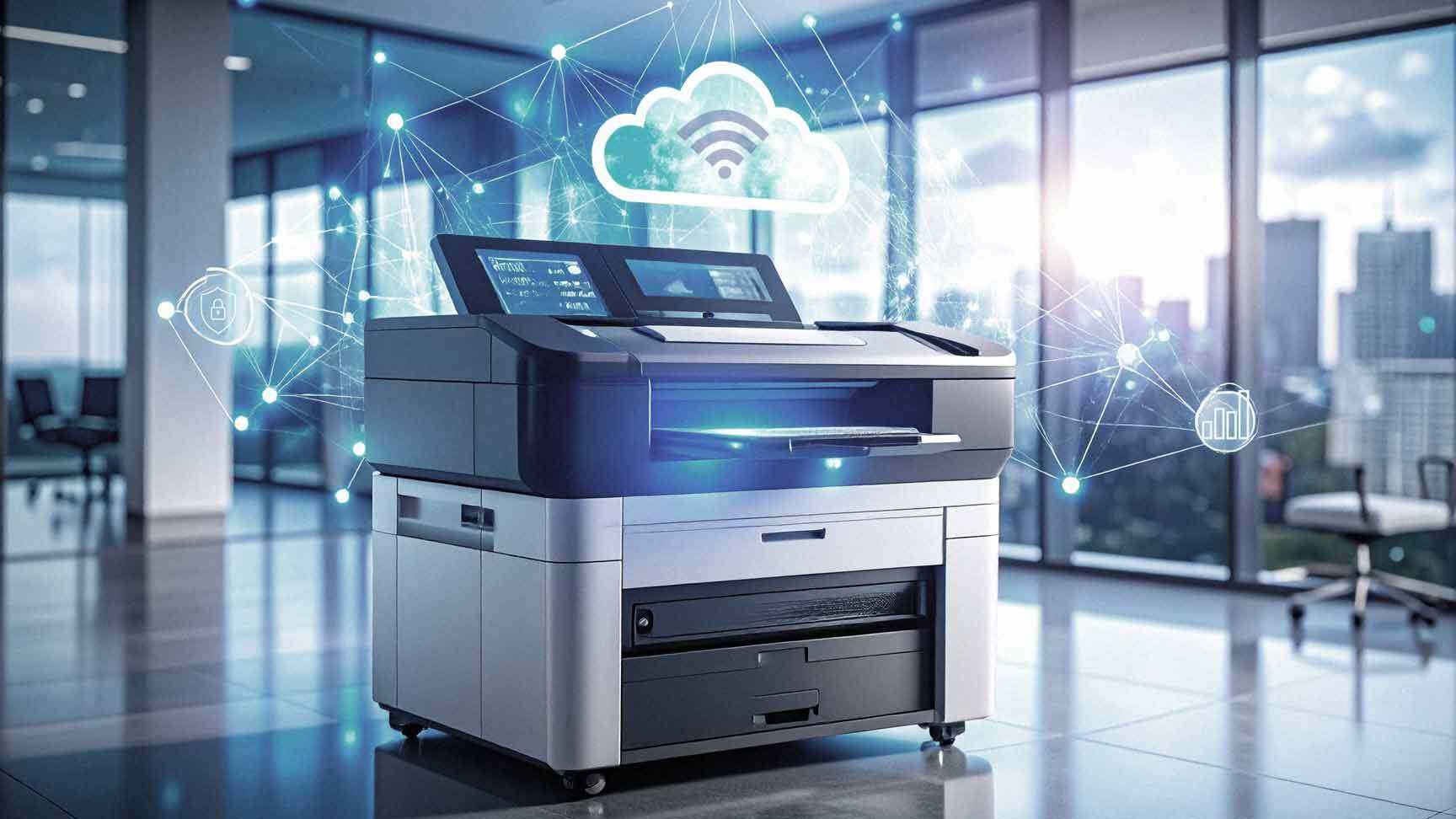How Internet of Things (IoT) Is Changing Office Printers and Why You Should Care
July 23rd, 2025 | 6 min. read

Office printers used to be simple. They printed documents, maybe scanned or faxed, and mostly sat in the corner until someone needed them. But times have changed.
Today’s printers are part of a larger system known as the Internet of Things, or IoT. That means your office printer is no longer just a printer; it's also a valuable asset. It is an innovative, network-connected device that can share data, communicate with cloud services, and play a role in both your productivity and your cybersecurity.
This might sound like something only big enterprises need to worry about, but that is no longer true. Small and mid-sized businesses utilize innovative printers every day, often without fully understanding the risks or opportunities associated with them.
In this article, we will explain what IoT means in the context of office printers, its impact on your business, the benefits it offers, and the risks you need to manage.
What Is IoT and How Does It Apply to Office Printers?
The Internet of Things refers to everyday physical devices that are connected to the Internet or a network. These devices collect and share data, and many can act on that data automatically.
You may already use IoT devices at home, such as smart thermostats or voice assistants. In a business setting, IoT encompasses tools such as smart security cameras, cloud-connected door locks, and, of course, multifunction printers that do more than just print.
Examples Of IoT In Your Office Right Now
Even if your company does not consider itself tech-heavy, you likely already use IoT devices. For example:
- A printer that sends you alerts when toner is low
- A copier that auto-orders supplies when inventory runs out
- A multifunction printer that stores scans in the cloud
- Print software that tracks usage and reports back to IT
If your office devices communicate with each other, store information, or exchange data through your network, they are part of the IoT landscape.
How Printers Became Networked and Smart Devices
Printers have quietly evolved. Years ago, they connected with a single desktop through a USB cable. Today, they are often cloud-enabled, email-capable, and managed over Wi-Fi or Ethernet.
Modern printers now include:
- Built-in storage
- Operating systems
- Web-based user interfaces
- Firmware updates over the internet
That makes them practical and efficient, but also potentially vulnerable.
What Smart Printers Can Do Today Thanks to IoT
Real-time Supply Alerts And Automatic Ordering
Many smart printers can now detect when toner or ink is running low and send notifications to your admin team or even place an order automatically.
This prevents downtime and helps avoid last-minute supply issues.
Remote Monitoring and Performance Tracking
Managed Print Services providers often utilize IoT capabilities to monitor your printer fleet remotely. They can identify usage trends, detect issues before they become problems, and optimize device placement across departments.
Built-in Analytics, Security Features, and Self-diagnosis
Smart printers can log activity, enforce print policies, and identify unauthorized access attempts. Some models even run self-checks and alert you if a part is wearing down or if a configuration is out of compliance.
Integration With Cloud Platforms like Microsoft 365 and Google Workspace
Many modern printers can connect directly to cloud storage. Employees can scan documents straight to OneDrive or Google Drive, or print files directly from email or cloud folders.
This supports hybrid work and reduces the need for extra steps or file transfers.
Related Article: Cloud Phones vs. Microsoft Teams Calling: What’s Right for Your Business?
Why IoT-Connected Printers Matter for Your Business
Improved Uptime and Proactive Service
With remote monitoring and self-diagnostics, your IT team or Managed Print provider can catch issues early. Instead of waiting for someone to report a problem, alerts go out automatically. That means fewer surprises and less downtime.
Better Control of Print Costs and Usage
IoT-enabled printers can track print volume by user or department. You can set print rules, restrict color printing to specific roles, or receive reports that show where waste is happening.
This level of visibility helps control costs and supports sustainability goals.
Enhanced Data Protection and Access Control
Smart printers can be configured to require authentication, such as a PIN or ID badge, before releasing a print job. This prevents confidential documents from sitting unattended in the output tray.
They also offer enhanced logging and auditing, which is particularly helpful for companies that must adhere to compliance standards.
Support For Hybrid and Remote Teams
With cloud integration, your remote employees can send print jobs to office printers securely or scan directly into shared cloud folders. This streamlines workflows across locations, helping everyone stay connected.
What Are the Risks of IoT Printers?
Cybersecurity and Network Vulnerability Concerns
Because IoT printers are network-connected, they can be vulnerable to hacking. If they are not adequately secured, they can be used to gain access to your entire network.
In recent years, several major printer brands have issued urgent firmware updates to address critical vulnerabilities. Failing to address these updates puts your business at risk.
Firmware Updates and Patching Challenges
Unlike computers, printers are often overlooked when it comes to software updates. But outdated firmware can contain known security flaws.
If you do not have a system in place for regular updates, your printers could be the weak link in your network security.
Misconfigured Devices and Access Exposure
Default settings on new printers often leave admin access open and unsecured. This creates opportunities for unauthorized users to modify settings, access stored data, or redirect print jobs.
Smart printers must be configured correctly from day one, with proper user access levels and password protections in place.
The Danger of Ignoring Print Security
Many companies invest heavily in cybersecurity for laptops and servers, but forget that printers also store and transmit sensitive data. That includes:
- Employee records
- Payroll documents
- Contracts and legal paperwork
- Customer data
A breach through your printer is still a breach. The consequences are the same, and often more preventable.
How to Take Advantage of IoT Without Taking on Risk
Work With a Provider Who Understands Secure Print Environments
Managed Print Services providers, such as AIS, specialize in deploying and securing smart printers for businesses. They can help you choose the right devices, configure them correctly, and monitor them for signs of trouble.
Learn more by reading, Are Managed Print Services Right For My Business?
Use Device Authentication and Secure Print Release
Make sure users must verify their identity before printing sensitive documents. This protects privacy and ensures that confidential information does not fall into the wrong hands.
Secure print release can be managed through PIN codes, ID badges, or single sign-on tools integrated with your existing systems.
Update Firmware Regularly and Restrict Admin Access
Your IT team should treat printers like any other connected device. That means:
- Applying firmware updates as soon as they are available
- Replacing default passwords with strong, unique ones
- Limiting admin access to authorized personnel only
These steps go a long way toward preventing misuse or unauthorized access.
Include Printers in Your Overall IT Security Policies
If your cybersecurity plan does not mention printers, it is time for an update. They need the same protections and monitoring as your computers, servers, and mobile devices.
Final Thoughts: Printers Are Now Part of Your IT Strategy
The modern office printer is no longer a basic appliance. It is an innovative, connected device that plays a role in your workflows, costs, and security.
Here is what business owners should remember:
- Smart printers offer convenience, automation, and improved efficiency
- They also create new risks if not configured or monitored properly
- Print security and performance can now be managed just like other parts of your IT infrastructure
If you are upgrading your print environment or reviewing your cybersecurity plan, make sure printers are part of the conversation.
Do you need help reviewing your current print setup or exploring smart printer options?
AIS can provide expert advice, real-world examples, and security-focused solutions that match your business goals. Reach out anytime for a no-pressure consultation.
A true southerner from Atlanta, Georgia, Marissa has always had a strong passion for writing and storytelling. She moved out west in 2018 where she became an expert on all things business technology-related as the Content Producer at AIS. Coupled with her knowledge of SEO best practices, she's been integral in catapulting AIS to the digital forefront of the industry. In her free time, she enjoys sipping wine and hanging out with her rescue-dog, WIllow. Basically, she loves wine and dogs, but not whiny dogs.
Topics:

